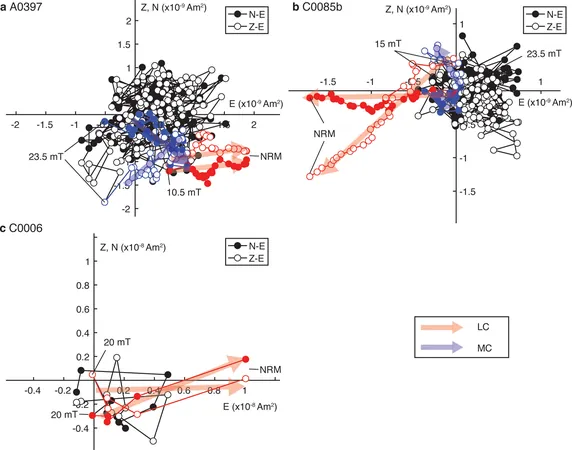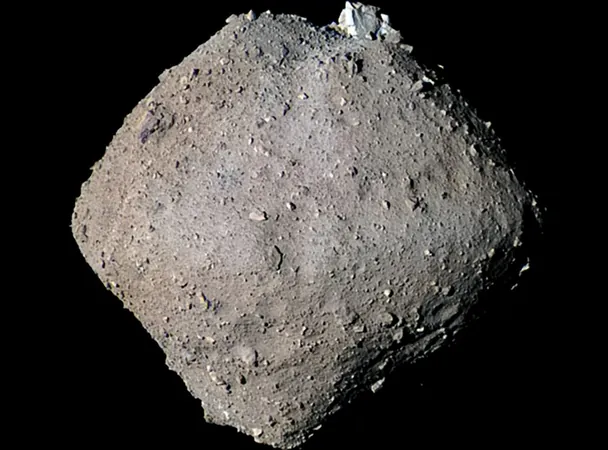
Asteroid Grains Illuminate the Origins of the Outer Solar System's Magnetic Forces!
2024-11-06
Author: Siti
Exciting revelations are emerging from the cosmos as tiny grains harvested from the asteroid Ryugu provide groundbreaking insights into the magnetic forces that influenced the far reaches of our solar system more than 4.6 billion years ago.
A multidisciplinary team of scientists, hailing from MIT and other esteemed institutions, has been studying these minuscule particles, which were collected by Japan’s JAXA Hayabusa2 mission and brought back to Earth in 2020. Researchers believe that Ryugu originally formed on the fringes of the early solar system, only to migrate inwards toward the asteroid belt, ultimately establishing a stable orbit between Mars and Earth.
In this latest study, the team meticulously examined Ryugu’s particles for remnants of any ancient magnetic fields that may have influenced the asteroid's initial formation.
Their findings suggest that if a magnetic field did indeed exist at the time, it would have been extremely weak—roughly 15 microtesla at its peak. For comparison, Earth’s magnetic field today is about 50 microtesla.
Despite this low intensity, experts speculate that such a weak magnetic force was ample to gather primordial gas and dust, paving the way for the creation of asteroids in the outer solar system and possibly aiding in the formation of the giant planets, from Jupiter to Neptune.
This study, published on November 6 in the journal AGU Advances, marks a significant milestone in our understanding of the distal solar system, indicating for the first time that a weak magnetic field was present.
While it has long been established that magnetic fields played a crucial role in shaping the inner solar system where Earth and its neighboring planets formed, the extent of this influence in the outer reaches was previously uncertain.
Benjamin Weiss, a prominent author of the study and esteemed Professor of Earth and Planetary Sciences at MIT, commented, “We are demonstrating that every area we examine shows signs of a magnetic field that contributed to mass accumulation during the formation of the sun and planets. This understanding now extends to the outer solar system.”
The study’s lead author, Elias Mansbach, currently a postdoctoral researcher at Cambridge University, elaborated on the formation of the solar system, which began approximately 4.6 billion years ago from a dense cloud of interstellar gas and dust.
This material collapsed, forming a swirling disk, with most of it converging at the center to create the sun. The remnants coalesced into a solar nebula of swirling, ionized material, wherein interactions between the nascent sun and the disk produced a magnetic field that permeated the nebula, significantly assisting in accreting matter that eventually formed planets, asteroids, and moons.
How far this magnetic field extended has been debated, particularly in contrast to the robust inner solar system magnetic fields, which have been measured between 50 to 200 microtesla.
While earlier studies predominantly relied on meteorites sourced from ecozones within the inner nebula, very few samples from the outer solar system were available for scrutiny.
The breakthrough came with the return of asteroid samples from Ryugu, allowing the scientists to analyze materials believed to reflect the early conditions of the outer solar system.
The grains, about a millimeter in size, were subjected to rigorous testing using a magnetometer in Weiss’ laboratory designed to measure the strength and orientation of magnetization.
Their analysis revealed no definitive record of a preserved magnetic field, leading to two hypotheses: either no magnetic field existed during Ryugu’s formation or it was too weak to imprinted on the asteroid's grains.
The latter was backed by estimations of a weak field possibly around 15 microtesla.
In an intriguing twist, the team also revisited previously studied meteorites known as 'ungrouped carbonaceous chondrites,' which were thought to have formed too late to record the early solar nebula's magnetic field.
Upon reassessing their ages, Mansbach and his team found these samples could date nearer to the solar system's inception, with one notably showing a positive field detection indicative of about 5 microtesla—again aligning with the upper limits of their external predictions.
This comprehensive investigation, combining evidence from Ryugu and updated meteorite samples, unveils a fascinating portrait of the early solar system, suggesting that even a delicate magnetic field could have played a pivotal role in the accretion of matter and the formation of the gas giants beyond 7 astronomical units from the sun.
As Weiss succinctly puts it, 'When you’re farther from the sun, a faint magnetic field can indeed have a significant impact.'
Looking ahead, the research team is poised to deepen their understanding of these celestial phenomena with forthcoming samples from another distant asteroid, Bennu, recently delivered to Earth by NASA's OSIRIS-REx spacecraft in September 2023.
With intriguing similarities between Ryugu and Bennu, the researchers are eagerly anticipating the insights that these new samples will unveil.

 Brasil (PT)
Brasil (PT)
 Canada (EN)
Canada (EN)
 Chile (ES)
Chile (ES)
 España (ES)
España (ES)
 France (FR)
France (FR)
 Hong Kong (EN)
Hong Kong (EN)
 Italia (IT)
Italia (IT)
 日本 (JA)
日本 (JA)
 Magyarország (HU)
Magyarország (HU)
 Norge (NO)
Norge (NO)
 Polska (PL)
Polska (PL)
 Schweiz (DE)
Schweiz (DE)
 Singapore (EN)
Singapore (EN)
 Sverige (SV)
Sverige (SV)
 Suomi (FI)
Suomi (FI)
 Türkiye (TR)
Türkiye (TR)